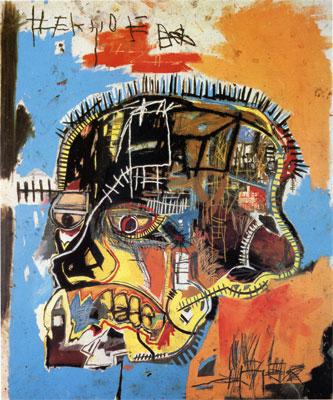Basquiat
dal 16/7/2005 al 10/10/2005
Segnalato da
16/7/2005
Basquiat
Museum of Contemporary Art - MOCA, Los Angeles
A Retrospective with over 100 works

Basquiat is a major retrospective of the brief but highly influential career of American artist Jean-Michel Basquiat (1960–88), a key figure of the 1980s whose work continues to resonate today. Recognized for its originality and emotional depth, Basquiat’s work focused on his personal and ethnic identity and incorporated a unique iconography that included urban culture, sports heroes, and music legends of the African-American community. Featuring over 100 works, many of which will be shown for the first time in Los Angeles, this major exhibition opens to the public at MOCA Grand Avenue (250 South Grand Avenue in downtown Los Angeles) on July 17, 2005 and remains on view through October 10, 2005.
Approximately 65 paintings and 50 works on paper demonstrate Basquiat’s skillful use of color, his aptitude for drawing, his integration of text into his canvases, and his development of African diaspora themes. This exhibition is the most comprehensive re-evaluation of the prolific artist’s career since his 1992 retrospective at the Whitney Museum of American Art in New York and spans the artist’s short but influential career from 1979 to 1988. Basquiat is organized by the Brooklyn Museum. The national tour of Basquiat is sponsored by JPMorgan Chase. Additional generous support has been provided by Fernwood Art Foundation. The Federal Council on the Arts and the Humanities has granted an indemnity for this exhibition. MOCA’s presentation is supported by the Ahmanson Foundation through the Ahmanson Curatorial Fellowship. This presentation is also made possible by major support from The Broad Art Foundation. Basquiat was the last major painter in an idiom that began many decades earlier in Europe with the adaptation of African art by modern artists such as Pablo Picasso and Henri Matisse. Inspired by his heritage as a child of the African diaspora, Basquiat’s work engaged in dialogue with that African-influenced modernist idiom, yet also transcended it. A self-taught artist, Basquiat possessed a precocious skill that set him apart from many others of his generation. He drew constantly, producing hundreds of works, which he sometimes photocopied to incorporate into his paintings as collage elements. He admired other draftsmen, including Leonardo da Vinci, whose anatomical studies he quoted, and Cy Twombly, whose influence is seen in many of Basquiat’s earliest works. Among the finest examples of this aspect of Basquiat’s work is a series of 32 drawings currently referred to as the Daros Suite; it once belonged to the legendary collector and dealer Thomas Ammann. The exhibition features the entire portfolio, seen for the first time in the United States.
This career-spanning retrospective brings Basquiat’s work back to Los Angeles, which occupies a landmark position in the artist’s history. Two seminal exhibitions were presented at the Larry Gagosian Gallery in 1982 and 1983, during which time Basquiat lived in Venice creating works such as Gold Griot (1984), painted on reassembled fence planks from his Venice backyard. Depicting a large, enigmatic head and torso on a gold background, this singular work illustrates the dichotomies and universal themes seen in Basquiat’s work throughout his career, including life and death, wealth and poverty, and integration and segregation.
As a painter, Basquiat made language an increasingly important feature of his work. Basquiat used words to elaborate his themes, adding layers of verbal complication to his pictorial ideas. Basquiat’s words also serve a compositional function, playing a key role in the graphic construction of a painting. Basquiat started his career as a graffiti writer, signing his work “SAMO©†(for “same old†or “same old shitâ€).
Just as famous African-American musicians such as Duke Ellington or Count Basie adopted royal titles as nicknames, Basquiat used crowns and haloes to ennoble his icons. In some paintings, the crowns top nameless generic figures. But more often, Basquiat crowned his heroes. These included renowned jazz musicians Charlie Parker and Dizzy Gillespie, and celebrated athletes such as Joe Louis, Sugar Ray Robinson, Cassius Clay (Mohammed Ali), and Hank Aaron.
As a teenager, Basquiat co-founded an art band called Gray that mixed ska and punk with “noise muzik.†He also performed in Deborah Harry’s music video for Rapture and produced his own record, Beat Bop (1983), now recognized as an early hip-hop classic. When Basquiat turned his energies to painting full time, music became a subject of his art. As a musician and performer, Basquiat performed in a feature film loosely based on his life entitled Downtown 81, directed by Edo Bertoglio (on view in Ahmanson Auditorium). A second film about his life, the posthumous Basquiat directed by artist Julian Schnabel, chronicles the artist’s rise to stardom, his famous friendship with Andy Warhol, and tragic death. The exhibition also includes the premiere of A Conversation with Jean-Michel Basquiat, a documentary film directed by Tamra Davis, in which he speaks candidly about his life and work (on view in Ahmanson Auditorium).
With its combination of music, dynamic wordplay, performance, and graffiti writing, Basquiat’s art embodied the hip-hop movement during its infancy in the late 1970s and early 1980s. In true hip-hop fashion, he incorporated what he needed—his pop poetry evokes the emcee. Basquiat approached the process of making art like a DJ: culling text, symbols, imagery, and styles from disparate sources and mixing them into something original.
The four exhibition curators are Marc Mayer, Basquiat project director, former deputy director for art at the Brooklyn Museum, and now director of the Musée d’art contemporain de Montréal; Fred Hoffman, Ahmanson Curatorial Fellow at MOCA; Kellie Jones, assistant professor of the history of art and African-American Studies, Yale University; and Franklin Sirmans, an independent writer, editor, and curator based in New York. MOCA’s presentation of Basquiat is coordinated by MOCA Associate Curator Alma Ruiz.
MUSEUM HOURS
Monday 11am–5pm
Tuesday and Wednesday
CLOSED
Thursday 11am–8pm (5–8pm FREE)
Friday 11am–5pm
Saturday and Sunday 11am–6pm
Closed New Year's Day, Independence Day, Thanksgiving, and Christmas.



